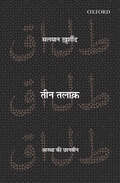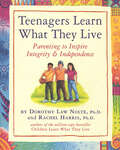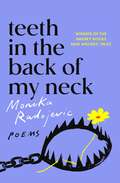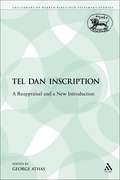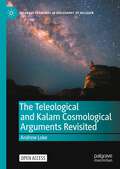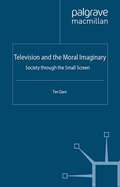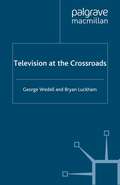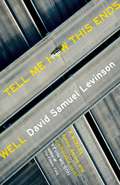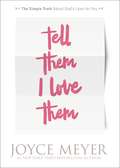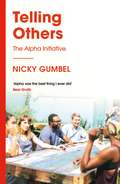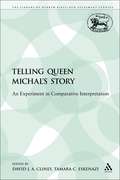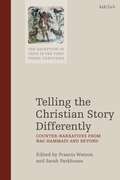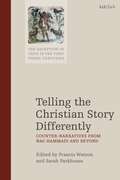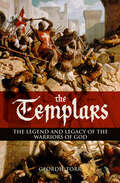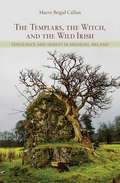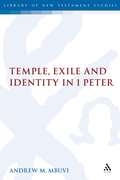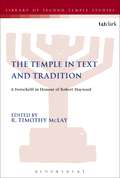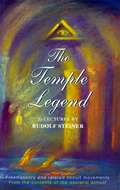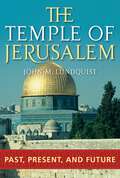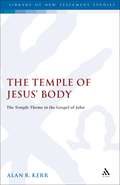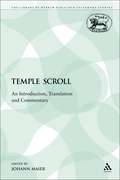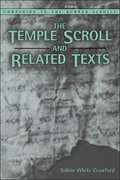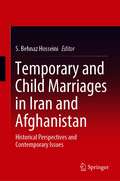- Table View
- List View
Teen Talaq: Aastha ki C haan-Been
by Salman KhurshidTriple talaq, or talaq-e-bidat, is one of the most debated issues not only in India but also in other countries having a sizeable Muslim population. Muslim men have regularly misused this provision to divorce their wives instantly by simply uttering 'talaq' thrice. The Supreme Court of India, in the landmark judgement Shayara Bano v. Union of India, finally topic but presents it simply, without much jargon. Explaining the reasons behind the court's decision, he goes on to discuss other aspects of this practice, such as why it is wrong; why this practice has thrived; what the previous judicial pronouncements on it were; what the Quran and Muslim religious leaders say about it; and what the comparative practices in other countries are. This is the Hindi translation of the English edition.
Teenagers Are People Too
by Joyce MeyerUsing the Bible as the ultimate guide toward the goal of spiritual and emotional maturity, #1 New York Times bestselling author Joyce Meyer teaches teens how to deal with emotional pain, loneliness, temptation, and relationships.
Teenagers Learn What They Live: Parenting to Inspire Integrity & Independence
by Rachel Harris L.C.S.W., Ph.D. Dorothy Law Nolte Ph.D.Parenting by example. Using the simple, powerful message that turned Children Learn What They Live into an international bestseller with over 1.5 million copies in print, Drs. Dorothy Law Nolte and Rachel Harris bring their unique perspective to families with adolescents. Structured, like the first book, around an inspirational poem, Teenagers Learn What They Live addresses the turbulent teenage years, when a stew of hormones, pressures, and temptations makes for such extreme challenges for parents and children. Teenagers addresses popularity and peer pressure ("If teenagers live with rejection, they learn to feel lost"); the responsibilities of maturity ("If teenagers live with too many rules, they learn how to get around them./ If teenagers live with too few rules, they learn to ignore the needs of others"); body image and the allure of cigarettes, drugs, and alcohol ("If teenagers live with healthy habits, they learn to be kind to their bodies"). Central to the book are ways for parents to communicate with their teenage children-including how to deal with being "tuned out" and when to start the conversation again-and how to strike the right balance between holding on and accepting a teen's growing independence. Hundreds of examples of parent-child interactions cover everything from the all-night graduation party to problems of sexual identity, providing great guidance as well as effective conversation starters.
Teeth in the Back of my Neck
by Monika RadojevicAn arresting debut collection about identity, ancestry and history, from a young poet selected as an inaugural winner of the #Merky Books New Writers' Prize, dedicated to discovering the best writers of a new generation.'This is a courageous, arresting debut from a poet to watch.' Independent'A vital contribution to literature' HUCKChosen as one of Bustle's Best Debut Books of 2021________________________________________Written with profound depth and insight, the poems in Teeth in the Back of My Neck explore the joys, the confusions and the moments of sadness behind having one's history scattered around the globe - and the way in which your identity is always worn on your skin, whether you like it or not.Bristling with tension and beautifully realised, Monika Radojevic's impressive debut collection is an introduction to one of the most exciting and impressive poets of her generation.
Teilhard Lexicon: Understanding the Language, Terminology and Vision of the Writings of Pierre Teilhard de Chardin
by Sion CowellWritten to enable researchers and students to better understand the specialised language of Teilhard's transdisciplinary approach, which he found himself compelled to develop as a means of expressing that extraordinary vision of a universe in process of convergence towards a cosmic centre of unity he identifies with the Cosmic Christ. All quotations in the Lexicon have been sourced from the French originals. The work includes a full bibliography of Teilhard's works in French and English. 2005 marks the 50th anniversary of Teilhard's death. Several conferences are planned to mark this anniversary.
The Tel Dan Inscription: A Reappraisal and a New Introduction (The Library of Hebrew Bible/Old Testament Studies)
by George AthasThe first book-length treatment of the most important, and controversial, inscription found in Israel in recent years. The inscription contains a possible mention of the name 'David' and is thought by many scholars to verify the existence of this king. Contains a full account of the discovery, epigraphic analysis, palaeographical analysis, possible arrangement of the three fragments discovered, textual analysis and historical commentary. It is more thorough in each of these treatments than any preceding discussion, and reviews all of the major theories about the inscription, with a well-considered conclusion.This is a volume 360 in the Journal for the Study of the Old Testament Supplement series and volume 12 in the Copenhagen International Seminar subseries.
The Teleological and Kalam Cosmological Arguments Revisited (Palgrave Frontiers in Philosophy of Religion)
by Andrew LokeA prominent issue in many contemporary philosophy of religion debates concerns whether the universe has a Designer. This book moves the discussion ahead in a significant way by devising an original deductive formulation of the Teleological Argument (TA) which demonstrates that the following are the only possible categories of hypotheses concerning fine-tuning and order: (i) chance, (ii) regularity, (iii) combinations of regularity and chance, (iv) uncaused, and (v) design. This book also demonstrates that there are essential features of each category such that, while the alternatives to design are unlikely, the Design Hypothesis is not, and that one can argue for design by exclusion without having to first assign a prior probability for design. By combining the TA with the Kalam Cosmological Argument (KCA) which it defends against various objections, this book responds to the God-of-the-gaps objection by demonstrating that the conclusion of the KCA-TA is not based on gaps which can be filled by further scientific progress, but follows from deduction and exclusion.This is an open access book.
Television and the Moral Imaginary: Society through the Small Screen
by T. DantJust how bad is television? Drawing on a range of theoretical sources including Husserl Lacan, Lefebvre, Sartre, Schutz and Adam Smith, this book takes a phenomenological approach to the small screen to offer an original sociological approach to television and its contribution to moral culture of late modern societies.
Television at the Crossroads
by G. Wedell B. LuckhamTelevision had, until recently, a social and cultural purpose. The BBC, and to a lesser extent ITV and Channel 4, were committed by the legal instruments establishing them to develop and maintain these purposes. With the enlargement of the range of choices for viewers by digital television and the provision of access to cable and satellite TV and the Internet, the role of the terrestrial television channels is being diluted. The authors examine the effects of this and consider whether anything can be done to maintain the standards and quality of television at a time of unlimited competition.
Tell Me How This Ends Well: A Novel
by David Samuel LevinsonIn 2022, American Jews face an increasingly unsafe and anti-Semitic landscape at home. Against this backdrop, the Jacobson family gathers for Passover in Los Angeles. But their immediate problems are more personal than political, with the three adult children, Mo, Edith and Jacob, in various states of crisis; the result, each claims, of a lifetime of mistreatment by their father, Julian.The siblings have begun to suspect that Julian is hastening their mother Roz's demise, and years of resentment boil over as they debate whether to go through with the real reason for their reunion: an ill-considered plot to end their father's iron rule forever. That is, if they can put their bickering, grudges, festering relationships and distrust of one another aside long enough to act. And God help them if their mother finds out . . . Tell Me How This Ends Well presents a blistering vision of near-future America, turning the exploits of one very funny, very troubled family into a rare and compelling exploration of the state of America itself.
Tell Them I Love Them: Receiving a Revelation of God's Love for You
by Joyce MeyerEvery bit of God's power and love is available to you-today! And you aren't just one of the crowd. God loves you as if you were the only person on Earth. The problem is that, like most people, you may not understand it...or if you know it with your head, you may not feel it with your heart. Now you can. The powerful message in this inspiring book will show you: How to recognize God's love inside you How to stop wondering if you're good enough for God How you can experience an amazing revelation of God's love How to find God even during life's painful circumstances, and How God's love will change you forever. Sharing her insights and the revelation that transformed her own life, Joyce Meyer brings you Scripture and other words of wisdom that can open up the window to God's love...and let its light shine on you, personally!
Telling Others: The Alpha Initiative (ALPHA BOOKS)
by Nicky Gumbel'What distinguishes Alpha from other initiatives is the easy going, relaxed feel of the proceedings - that and its astonishing success.' - The TimesTelling Others imparts the vision, excitement and challenge of Alpha, with a practical guide to running a successful course. Perfect as a resource for churches, the book details the principles and structure of Alpha, tips on hosting small groups and giving talks, and guidance on pastoral care. A series of appendices provides suggestions for practicalities such as administration and running daytime and workplace courses, and advice on avoiding common mistakes and pitfalls. The chapters are interspersed with testimonies, written in their own words, from people whose lives have been changed by God through Alpha.
Telling Queen Michal's Story: An Experiment in Comparative Interpretation (The Library of Hebrew Bible/Old Testament Studies)
by David J. Clines Tamara C. EskenaziThis book, an anthology of previously published writing about Michal together with some new and original essays, is something of an experiment. Its purpose is to provide reders with raw materials for developing their own reading of the Michal story. It does not offer a unified portrait of this biblical character, but rather invites readers to form their own assessment interactively with these readings of the Michal story. At the same time, this book presents some systematic guidance for coping with these divergent interpretations of the complex and tantalizing figure of Michal.
Telling the Christian Story Differently: Counter-Narratives from Nag Hammadi and Beyond (The Reception of Jesus in the First Three Centuries)
by Francis Watson Sarah ParkhouseThis volume examines the 'counter-narratives' of the core Christian story, proposed by texts from Nag Hammadi and elsewhere. A noteworthy body of highly respected scholars examine material that is sometimes difficult and often overlooked, contributing to the ongoing effort to integrate Nag Hammadi and related literature into the mainstream of New Testament and early Christian studies. By retracing the major elements of the Christian story in sequence, they are able to discuss how and why each aspect was disputed on inner-Christian grounds, and to reflect on the different accounts of Christian identity underlying these disputes. Together the essays in this book address a central issue: towards the end of the second century, Irenaeus could claim that the overwhelming majority of Christians throughout the world were agreed on a version of the core Christian story which is still recognisable today. Yet, as Irenaeus concedes and as the Nag Hammadi texts have confirmed, there were many who wished to tell the core Christian story differently. Those who criticized and rejected the standard story did so not because they were adherents of another religion, 'Gnosticism', but because they were Christians who believed that the standard account was wrong at point after point. Ranging from the Gospels of Judas and Mary to Galatians and Ptolemy's Letter to Flora, this volume provides a fascinating analysis of how the Christian story as we know it today developed against counter-readings from other early Christian traditions.
Telling the Christian Story Differently: Counter-Narratives from Nag Hammadi and Beyond (The Reception of Jesus in the First Three Centuries)
by Francis Watson Sarah ParkhouseThis volume examines the 'counter-narratives' of the core Christian story, proposed by texts from Nag Hammadi and elsewhere. A noteworthy body of highly respected scholars examine material that is sometimes difficult and often overlooked, contributing to the ongoing effort to integrate Nag Hammadi and related literature into the mainstream of New Testament and early Christian studies. By retracing the major elements of the Christian story in sequence, they are able to discuss how and why each aspect was disputed on inner-Christian grounds, and to reflect on the different accounts of Christian identity underlying these disputes. Together the essays in this book address a central issue: towards the end of the second century, Irenaeus could claim that the overwhelming majority of Christians throughout the world were agreed on a version of the core Christian story which is still recognisable today. Yet, as Irenaeus concedes and as the Nag Hammadi texts have confirmed, there were many who wished to tell the core Christian story differently. Those who criticized and rejected the standard story did so not because they were adherents of another religion, 'Gnosticism', but because they were Christians who believed that the standard account was wrong at point after point. Ranging from the Gospels of Judas and Mary to Galatians and Ptolemy's Letter to Flora, this volume provides a fascinating analysis of how the Christian story as we know it today developed against counter-readings from other early Christian traditions.
The Templars: The Legend and Legacy of the Warriors of God
by Geordie TorrShrouded in myth and conspiracy, the history of the Knights Templar is little understood. Geordie Torr pulls fact from fiction, revealing the astonishing tale of this military-religious order that dominated the politics of the medieval Middle East. Initially created to protect Christian pilgrims to the Holy Land in the wake of the First Crusade, the Templars soon became an institution of incredible power, possessing wealth and influence throughout the courts of Europe. Yet just two centuries later they dramatically fell as its members were accused of heresy and burned at the stake, though some were believed to have survive and secretly kept serving God. Clearly and chronologically written, this illustrated book brings to life the legacy of this secretive order and the characters who defined the era, making it an informative and enjoyable read.
The Templars, the Witch, and the Wild Irish: Vengeance and Heresy in Medieval Ireland
by Maeve Brigid CallanEarly medieval Ireland is remembered as the "Land of Saints and Scholars," due to the distinctive devotion to Christian faith and learning that permeated its culture. As early as the seventh century, however, questions were raised about Irish orthodoxy, primarily concerning Easter observances. Yet heresy trials did not occur in Ireland until significantly later, long after allegations of Irish apostasy from Christianity had sanctioned the English invasion of Ireland. In The Templars, the Witch, and the Wild Irish, Maeve Brigid Callan analyzes Ireland’s medieval heresy trials, which all occurred in the volatile fourteenth century. These include the celebrated case of Alice Kyteler and her associates, prosecuted by Richard de Ledrede, bishop of Ossory, in 1324. This trial marks the dawn of the "devil-worshipping witch" in European prosecutions, with Ireland an unexpected birthplace.Callan divides Ireland’s heresy trials into three categories. In the first stand those of the Templars and Philip de Braybrook, whose trial derived from the Templars’, brought by their inquisitor against an old rival. Ledrede’s prosecutions, against Kyteler and other prominent Anglo-Irish colonists, constitute the second category. The trials of native Irishmen who fell victim to the sort of propaganda that justified the twelfth-century invasion and subsequent colonization of Ireland make up the third. Callan contends that Ireland’s trials resulted more from feuds than doctrinal deviance and reveal the range of relations between the English, the Irish, and the Anglo-Irish, and the church’s role in these relations; tensions within ecclesiastical hierarchy and between secular and spiritual authority; Ireland’s position within its broader European context; and political, cultural, ethnic, and gender concerns in the colony.
Temple, Exile and Identity in 1 Peter: Temple, Exile And Identity In 1 Peter (The Library of New Testament Studies #345)
by Andrew Mutua MbuviTemple, Exile and Identity in 1 Peter will generate a fresh and perhaps even a new understanding of the main themes of 1 Peter, which include questions of identity, suffering, hope, holiness, and judgment. Mbuvi explores the temple imagery in the epistle of 1 Peter and focuses on the use of cultic language in constituting the new identity of the Petrine community. He contends that temple imagery in 1 Peter undergirds the entire epistle. 1 Peter directly connects the community's identity with the temple by describing it in terms reminiscent of the temple structure. He calls the members of the community "living stones", formulating an image that has been categorized as a "Temple-Community." This concern with the temple characterizes the restoration eschatology in the Second Temple period with its focus on the establishment of the eschatological temple. Restoration of Israel was also to be characterized by hope for the re-gathering of the scattered of Israel, the conversion or destruction of the Gentiles, and the establishment of God's universal reign, all of which are reflected in the discourse of the epistle.
The Temple in Text and Tradition: A Festschrift in Honour of Robert Hayward (The Library of Second Temple Studies #83)
by R. Timothy McLayThe Second Temple period is an era that marked a virtual explosion in the world of literature, with the creation, redaction, interpretation, and transmission of Jewish texts that represented diverse languages and ideologies. The creation of many of these writings coincided with the growth of the Jewish community beyond the borders of Israel; therefore, among those for whom the Temple played a diminishing role. The transition period from Temple to texts was accompanied by conflicting interpretations about the role of the Temple as well as diverse theological understandings about God and the Jewish people. Drawing on the expertise of leading specialists in Second Temple Judaism, Temple, Texts, and Traditions explores the rich traditions of the Jewish people as they were expressed and interpreted in their writings in that period, which included writings that later became recognized as Scriptures.
The Temple Legend: Freemasonry and Related Occult Movements from the Contents of the Esoteric School
by Rudolf SteinerIn these unique lectures, given to members of his Esoteric School (1904-14), Rudolf Steiner's main intention is to throw light on the hidden content of the picture-language of myths, sagas and legends. Pictures, he explains, are the real origin of all things - the primeval spiritual causes. In order to work in a healthy way with pictures or symbols today, however, it is necessary that one should first become acquainted with their esoteric content - to understand them. At the time of these lectures Steiner was planning to inaugurate the second section of the Esoteric School, which was to deal in a direct way with a renewal - out of his own spiritual research - of ritual and symbolism. He gave these lectures as a necessary preparation, to clarify the history and nature of the cultic tradition. He thus discusses principally Freemasonry and its background, but also the Rosicrucians, Manichaeism, the Druids, the Prometheus Saga, the Lost Temple, Cain and Abel - and much else besides.
The Temple of Jerusalem: Past, Present, and Future
by John M. LundquistAs war and terrorism continue to rage over the Holy Land, the Temple of Jerusalem, arguably the most famous sacred structure in world history, looms in the background as a symbol of past glory, a place of religious worship, and a site to be contended over and coveted. This book offers a general history of the meaning, importance, and significance of the Temple of Jerusalem, in both the religious and the political arena. It begins with the construction of the Temple, its destruction in 587 B.C.E., its reconstruction in 516 B.C.E., the vast enlargement during the time of the Idumean King Herod, around 20 B.C.E., its final destruction in 70 C.E., and its dynamic and abundant afterlife as the leading influence in the construction of Jewish synagogues, Christian cathedrals, and Islamic mosques. But the Temple has also been at the center of much political and religious controversy, and Lundquist explores the issues and conflicts that have erupted over this sacred place, considers the meaning and importance of the Temple to Christianity, Judaism and Islam, from ancient times to the present, and concludes with a careful consideration of the continuing religious and political tensions.On September 28, 2000, Ariel Sharon visited the Temple Mount (also called Al-Haram As-Sharif) in Jerusalem, igniting what has come to be known as the second intifada. But why would such a visit to a religious site set off such a string of violent responses that continue to this day? The answer lies in the history of the Temple of Jerusalem, which once, indeed twice, stood in the spot known today as the Temple Mount (to Jews) and the Dome of the Rock (to Muslims). A holy place to three of the world's main religions—Christianity, Judaism, and Islam—the Temple of Jerusalem is, arguably, the most famous sacred structure in world history and figures prominently in Apocalyptic writings. Yet, it is almost entirely absent, in all its phases, from the archaeological record, as the sacred nature of the site prohibits any excavation.
The Temple of Jesus' Body: The Temple Theme in the Gospel of John (The Library of New Testament Studies #220)
by Alan KerrThis book is a study of the Johannine Christian response to the fall of the Jerusalem Temple in 70 ce. A crucial text in this investigation is Jn 2.13-22 and its context, which provide a lens through which other texts in John are viewed. Kerr's examination of the Temple festivals of Passover, Tabernacles, Dedication suggests that in Jesus fulfils and replaces these, while in the case of the Sabbath he effects a transformation. The overall conclusion is that the Johannine Jesus replaces and fulfils the Jerusalem Temple.
The Temple Scroll: An Introduction, Translation and Commentary (The Library of Hebrew Bible/Old Testament Studies #34)
by Johann MaierThe introduction, translation and commentary on the Temple Scroll by Johann Maier has been thoroughly revised and updated by the author for its English edition, taking account of improvements in readings, and, among other recent secondary literature, the English translation of Yadin's edition, to which cross-references are given. Students of Second Temple Judaism, and the Dead Sea Scrolls in particular, will at last have a convenient English edition of this most important document from Qumran.
Temple Scroll and Related Texts (Companion to the Qumran Scrolls)
by Sidnie White CrawfordThe Temple Scroll and Related Texts, one of the series Companion to the Qumran Scrolls, is a comprehensive roadmap to the Temple Scroll, the longest and one of the most complex of the manuscripts from Qumran. The central chapter contains a discussion of the contents of the Temple Scroll, including sections on the Temple and its courts, purity regulation, the festival calendar, and the Deuteronomic Paraphrase with the Law of the King. The Companion also includes a chapter on the Description of the New Jerusalem, as well as one on the relationship of the Temple Scroll to the Book of Jubilees, 4QMiqsat Ma'aseh ha-Torah, and the Damascus Document. Written in accessible language and featuring extensive bibliographies, this Companion is ideal for undergraduate and graduate classes.
Temporary and Child Marriages in Iran and Afghanistan: Historical Perspectives and Contemporary Issues
by S. Behnaz HosseiniThis book discusses the popularity of temporary and child marriages in Iran and Afghanistan and explores their historical background and the reasons why they still persist today. Further, it offers readers insights into the emotional and psychological violence that the women who have been subjected to these practices experience. The respective contributions address the persistence of these traditions, their ramifications for the wellbeing of women and the development of societies and human relations. Taken together, they offer an excellent academic tool for students, academics and researchers studying the anthropology and sociology of kinship, and family in the Middle East.
